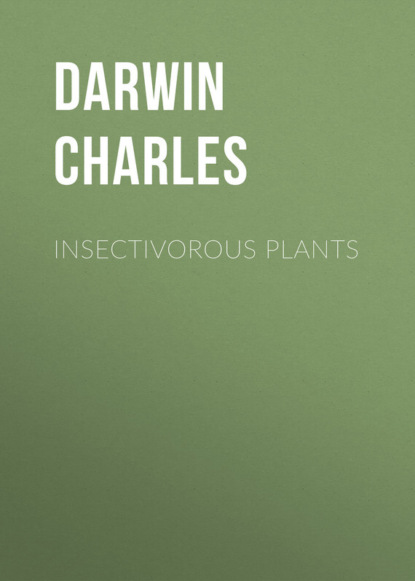 Полная версия
Полная версияInsectivorous Plants
73
Fritz Mller, 'Facts for Darwin, ' Eng. trans. 1869, p. 139. The rhizocephalous crustaceans are allied to the cirripedes. It is hardly possible to imagine a greater difference than that between an animal with prehensile limbs, a well-constructed mouth and alimentary canal, and one destitute of all these organs and feeding by absorption through branching root-like processes. If one rare cirripede, the Anelasma squalicola, had become extinct, it would have been very difficult to conjecture how so enormous a change could have been gradually effected. But, as Fritz Mller remarks, we have in Anelasma an animal in an almost exactly intermediate condition, for it has root-like processes embedded in the skin of the shark on which it is parasitic, and its prehensile cirri and mouth (as described in my monograph on the Lepadidae, 'Ray Soc.' 1851, p. 169) are in a most feeble and almost rudimentary condition. Dr. R. Kossmann has given a very interesting discussion on this subject in his 'Suctoria and Lepadidae,' 1873. See also, Dr. Dohrn, 'Der Ursprung der Wirbelthiere,' 1875, p. 77.
74
Sachs, 'Trait de Botanique' 3rd edit. 1874, p. 1026.
Dr. Warming 'Sur la Diffrence entres les Trichomes,' Copenhague, 1873, p. 6. 'Extrait des Videnskabelige Meddelelser de la Soc. d'Hist. nat. de Copenhague,' Nos. 10-12, 1872.
75
'Trait de Botanique' 3rd edit. 1874, p. 844. See also for following facts pp. 64, 76, 828, 831.
Since this sentence was written, I have received a paper by Gorup-Besanez ('Berichte der Deutschen Chem. Gesellschaft,' Berlin, 1874, p. 1478), who, with the aid of Dr. H. Will, has actually made the discovery that the seeds of the vetch contain a ferment, which, when extracted by glycerine, dissolves albuminous substances, such as fibrin, and converts them into true peptones.
76
See the abstract of his memoir on the contractile tissues of plants, in the 'Annals and Mag. of Nat. Hist.' 3rd series, vol. xi. p. 188.)
77
'English Botany,' by Sir J.E. Smith; with coloured figures by J.
78
The 'Quart. Mag. of the High Wycombe Nat. Hist. Soc.' July 1868, p. 5. Delpino ('Ult. Osservaz. sulla Dicogamia,' &c. 1868-1869, p. 16) also quotes Crouan as having found (1858) crustaceans within the bladders of Utricularia vulgaris.
I am much indebted to the Rev. H.M. Wilkinson, of Bistern, for having sent me several fine lots of this species from the New Forest. Mr. Ralfs was also so kind as to send me living plants of the same species from near Penzance in Cornwall.
79
'Beitrage zur Biologie der Plflanzen' drittes Heft, 1875.
80
I infer that this is the case from a drawing of a seedling given by Dr. Warming in his paper, "Bidrag til Kundskaben om Lentibulariaceae," from the 'Videnskabelige Meddelelser,' Copenhagen, 1874, Nos. 3-7, pp. 33-58.)
81
'New York Tribune,' reprinted in the 'Gard. Chron.' 1875, p. 303.
82
Prof. Oliver has figured a plant of Utricularia Jamesoniana ('Proc. Linn. Soc.' vol. iv. p. 169) having entire leaves and rhizomes, like those of our present species; but the margins of the terminal halves of some of the leaves are converted into bladders. This fact clearly indicates that the bladders on the rhizomes of the present and following species are modified segments of the leaf; and they are thus brought into accordance with the bladders attached to the divided and floating leaves of the aquatic species.
83
Prof. Oliver has given ('Proc. Linn. Soc.' vol. iv. p. 169) figures of the bladders of two South American species, namely Utricularia Jamesoniana and peltata; but he does not appear to have paid particular attention to these organs.
'Travels in the Interior of Brazil, 1836-41,' p. 527.
84
'Proc. Linn. Soc.' vol. iv. p. 171.
85
"Bidrag til Kundskaben om Lentibulariaceae," Copenhagen 1874.



